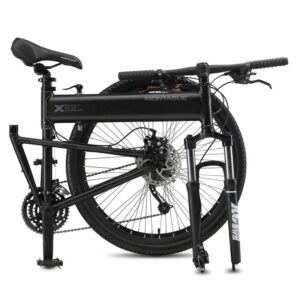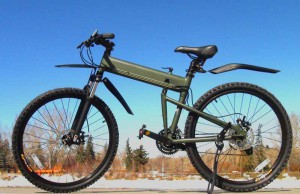The following is a guest post from Ed, a long-time reader of Preparedness Advice. It covers getting home during emergencies when vehicles are not available. This scenario could occur for a number of reasons, from earthquake damage to EMP, and preparing for this possibility must be part of your survival plans.
Many people work in the city and have a long commute back home. Suppose your usual automobile commute were prevented and you needed to get home without driving? What is your plan?
The questions you need to ask are:
- How far is the actual ROAD MILEAGE you must travel to get back home?
- How far is the Alternate road route, the Contingency direct overland route, or the EMERGENCY stealthy movement, hide during the day and travel at night evasion route? These alternate routes will provide you with more options and having them will make it easier to make quick decisions based on rapidly changing circumstances.
- Do you have enough supplies to get you there?
- How many friends, safe houses or “hides” along the way have you validated between here and there?
- Have you ever actually walked or biked that route and your alternate plus any contingency routes that would come off of those?
- What are the two most probable obstructions on your escape routes? They most likely will include probably weather and danger from other humans!
- What do you need most to mitigate the weather? Maybe sunscreen, a big hat and 2 gallons of water or in cold-wet weather head to toe Goretex rain gear, a sweater and warm neck gaiter. Sturdy boots!
- What about social unrest? Do you have a legal self defense tool in your vehicle, hidden in the passenger compartment, in the trunk or in that Get Home Bag that you tote around. OK, how effective is your KBar or hatchet when it comes time to face down an armed criminal? A knife is a last ditch effort to survive when you don’t have time to assemble and load your legally compliant, safely cased, stored and empty, therefore very useless gun. If concealed carry is legal in your state, get training, get the permit and carry all the time whereever it is legal for you to do so. Be discreet and vigilant!
- So much for the big worries, what else do you need? Being realistic and practical about needs is more important than any list of “survival must-haves” that may or may not apply to you and your scenario. Goretex head to toe, Balaclava, sweater, neck gaiter, warm gloves, utility cook pot, water filter, AMK space blankets 2 ea, 550 cord and duct tape, fire making kit, two days food supply, spare eye glasses, personal meds, a pair of binoculars, pistol and ammo, IF you have a permit and are legal to carry. Keep a pair of sturdy walking boots in your vehicle or office. Now what else are you missing?
- Where’s the med kit? Pain meds, because finishing that 20-mile trek after you’ve pulled a muscle or sprain an ankle will have you miserable without them.
- iPAL Phone/radio charger….because outlets are everywhere, as are 12 v power outlets…
- A $100.00 bill rolled tightly and carried in a keychain pill bottle on your neck knife because a room, or a meal, replacement clothing, etc will not be covered by the contents of your wallet, when the power is out and Internet is down so that nobody is making credit card transactions.
- Finally, a 4-way Silcock key. Clean water is available on the sides of commercial buildings, IF you can operate the spigots.
I carry a non-military looking, ‘urban commuter backpack’, with my gear in it. What I usually wear (depending on weather) is Duluth or Carhartt double-panel work pants, synthetic short or long sleeved shirt and a dull colored plaid shirt (thrift store – but not ratty looking). I like the Duluth fire hose pants because they have one longitudinal pocket on either thigh to store gear in, plus the pocket opening below the knee to insert pads. My knees thank me every day for those pads. Behind the knee pads is a good place to hide extra cash, taped to the inside of a pad before inserting it into the pocket.
My pack has a Natick or Esbit stove and fuel tabs, water filter and purification tablets. I carry a Gore Tex wind/rain suit for use as an added layer at night. I rely on stealth and want my gear to blend in and give the appearance of an average ‘blue collar worker’, combining durability and functionality. Military gear and 5.11 pants make you stand out in the crowd. You don’t want to look like a cop or Fed to the criminals who might want target you to steal your stuff.
Consider your “area of operations.” What tools or gear are most useful in and near the city? Consider some heavy duty wire cutters, strong enough to cut chain link or barbed wire fence if your route is blocked? A tire repair kit in the car and a decent spare in which you have checked the air are critical. A separate bag with complete change of clothing is needed to swap the “rural” look for “gray man in the city” where or when needed? It would take up little trunk space and is well worth it. Then comes the “snivel gear”.
I carry a USGI poncho which double as a shelter tarp, poncho liner, Adventure Medical bivvy sack and a fabric backed space blanket. Also handy is a box of small binder clips in a small zippered or drawstring bag, 25 feet of knotted rope with loops for feet and hands nearest the hook, to make clearing the top of a wall much easier, and a folding grappling hook. Remember, that all of those loops and knots will take up rope, so start with at least 50 feet…
A quality LED headlamp with RED, BLUE or GREEN LEDs to preserve night vision. You want light that is hands free at times. Must haves are a ferro-rod fire starter, change of dry clothes, PAPER MAP, water filter, and a FULL tank of gas on going into the city, as that allows me to launch back home and get there without stopping! You don’t want to look like a target by having a lot of stuff.
Distinguish between gear which will stay in the car versus the must-haves which go into your 10 kilogram maximum “Grab and Go” bag that you WILL carry when you must get out and walk the rest of the way and abandon your car. If a bicycle is your “Plan B” you are less limited. It comes down to weight vs need, as the situation will dictate. Make a plan and think about options now.

Traversing slopes becomes MUCH harder as you age. Shortly after 9/11 I had a situation which required me to walk from my office home in low rolling terrain. I didn’t pace myself and ended up asking a neighbor for a ride the last few miles! I took six hours to go 15 miles and was traveling light, carrying maybe 8 pounds, and was in good shape for my age, 53 at the time. I had done a lot of hiking the hills, but talk about a reality check! The first 10 miles went quickly, then I hit the wall, as hips and lower back really tightened up. It was well worth finding out my limits before I really found out the hard way. That’s why I carry food, fire and shelter to rest up overnight; slow and steady I will eventually get there. I went shopping for a bicycle soon afterwards.
After you have actually walked your “escape” route home over a weekend as a drill, you will come to understand why the Swiss Army used bicycles for so long. My Plan B = BICYCLE! Some links to look at folding bicycles:
Ed

Take a look at the links to the folding bikes, there are many good choices. You can always use them for bugging out or getting home In some background information Ed sent me he commented that “My Niece commuted on bicycle daily when she was taking her Masters at Columbia. She found the lower priced Citizen bike adequate in the city, but for use on dirt roads and off road trails a dual-sport or folding mountain bike is better”. He said that his prefered getting home bike would be a Monteague Paratrooper.
Make sure you have what you need for getting home in an emergency.
Howard


Good advice. I looked up the sillcock key and they are available and quite reasonable. A good addition that I had not thought of, but will add in the future. Thanks
Good YouTube on Sillcock key:
https://www.youtube.com/watch?v=R_YvBVGXFkk
I got mine on Amazon!
https://www.amazon.com/Cobra-Products-PST154-4-Way-Sillcock/dp/B0002YVMEM
Great Tips! Thanks for sharing your ideas.